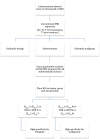Use of an internal reference in semi-quantitative dynamic contrast-enhanced MRI (DCE MRI) of indeterminate adnexal masses
- PMID: 25237836
- PMCID: PMC4207159
- DOI: 10.1259/bjr.20130730
Use of an internal reference in semi-quantitative dynamic contrast-enhanced MRI (DCE MRI) of indeterminate adnexal masses
Abstract
Objective: Semi-quantitative dynamic contrast-enhanced MRI (DCE MRI) has proven useful in discriminating benign from borderline/malignant adnexal lesions. Our aim was to assess if the use of a lesion-to-internal-reference ratio improved the performance in characterizing adnexal masses and which internal reference was suitable.
Methods: Semi-quantitative DCE MRI images of 71 indeterminate adnexal lesions were retrospectively reviewed. A region of interest was manually drawn onto the enhancing solid component, psoas muscle and normal outer myometrium. The DCE parameters were evaluated, and the lesion-to-internal-reference ratios were calculated.
Results: When the wash in rate of the lesion was higher than that of the myometrium, 97% specificity and 12% sensitivity for borderline/malignancy was reached. When the maximum relative enhancement and maximum absolute enhancement (SImax) of the lesion was less than those of the psoas, 100% specificity for benignity was achieved. The highest area under the curve (AUC) (0.807) was achieved using a SImax lesion-myometrium ratio. A slightly lower AUC (0.799) was achieved using a SImax lesion-psoas ratio, but the psoas muscle was more frequently measurable in the same slice as the lesion ROI. Although the AUC was higher, when using ratios instead of individual DCE values, this was not significantly different.
Conclusion: DCE MRI has added diagnostic value in the assessment of adnexal lesions, and the use of internal references enables high specificity for malignancy and benignity. Lesion-internal-reference ratios have no added diagnostic value over DCE values alone.
Advances in knowledge: Both psoas muscle and myometrium are suitable internal references in the DCE assessment of adnexal lesions enabling high specificity for malignancy and benignity.
Figures


References
-
- Bernardin L, Dilks P, Liyanage S, Miquel ME, Sahdev A, Rockall A. Effectiveness of semi-quantitative multiphase dynamic contrast-enhanced MRI as a predictor of malignancy in complex adnexal masses: radiological and pathological correlation. Eur Radiol 2011; 22: 880–90. doi: 10.1007/s00330-011-2331-z - DOI - PubMed
-
- Sohaib SA, Sahdev A, Van Trappen P, Jacobs IJ, Reznek RH. Characterization of adnexal mass lesions on MR imaging. AJR Am J Roentgenol 2003; 180: 1297–304. - PubMed
MeSH terms
Substances
LinkOut - more resources
Full Text Sources
Other Literature Sources
Medical

